Catching the eye in the Great Refectory of the San Benedetto Po monastic complex is undoubtedly the Last Supper by Girolamo Bonsignori (Verona, 1472 - Mantua, 1529), a monumental work that returned after more than two centuries to its original location. An event that thrilled the citizens of the village in the lower Mantua area, as a masterpiece that summarizes an important piece of the history of the Polirone community, but also attracted visitors from all over Italy on the occasion of the exhibition in which the great painting became the protagonist, The Sixteenth Century in Polirone. From Correggio to Giulio Romano, and above all, it sparked a renewed interest in studies and analyses of works related to the area.
The exhibition project is part of the celebrations that Mantua wished to dedicate to one of the artists who made the greatest artistic contribution to the city, Giulio Romano (Rome, c. 1499 - Mantua, 1546), the pupil of Raphael (the Urbino artist’s five-hundredth anniversary of his death falls) universally known for having created in Mantua’s Palazzo Te one of the most evocative and impressive settings of Mannerism and of the entire history of Italian art, the Camera dei Giganti. The artist is honored with no less than two exhibitions, at Palazzo Ducale and Palazzo Te, and as already stated with the San Benedetto Po review, since he was the architect of the renovation of the Polironian complex during the 16th century.
With a clear detachment from blockbuster exhibitions, curator Paolo Bertelli reiterated in the introduction to the exhibition catalog that The Sixteenth Century at the Polirone is “an opportunity for San Benedetto Po to reclaim its past once more, to overcome limits and boundaries, to create bridges and links, to make recoveries of works of art and restorations.” An opportunity to start a new season of studî, such as the one that took place in 1989, in conjunction with the exhibition Dal Correggio a Giulio Romano. The Commissioning of Gregorio Cortese, a title that among other things echoes the subtitle of the current exhibition, and the related volume edited by Paolo Piva and Egidio Del Canto. In curator Bertelli’s intentions there was an exhibition with study, popularization, reception and proposition at its base. And indeed this has led “to the renewal of the setting of the Refettorio Grande, to the enhancement and rediscovery of many works, to a campaign of non-invasive analysis on the paintings, to a study of the textile apparatus, to the restoration of some works on display and to the publication of a dedicated volume,” as well as to the return of Bonsignori’s Last Supper .
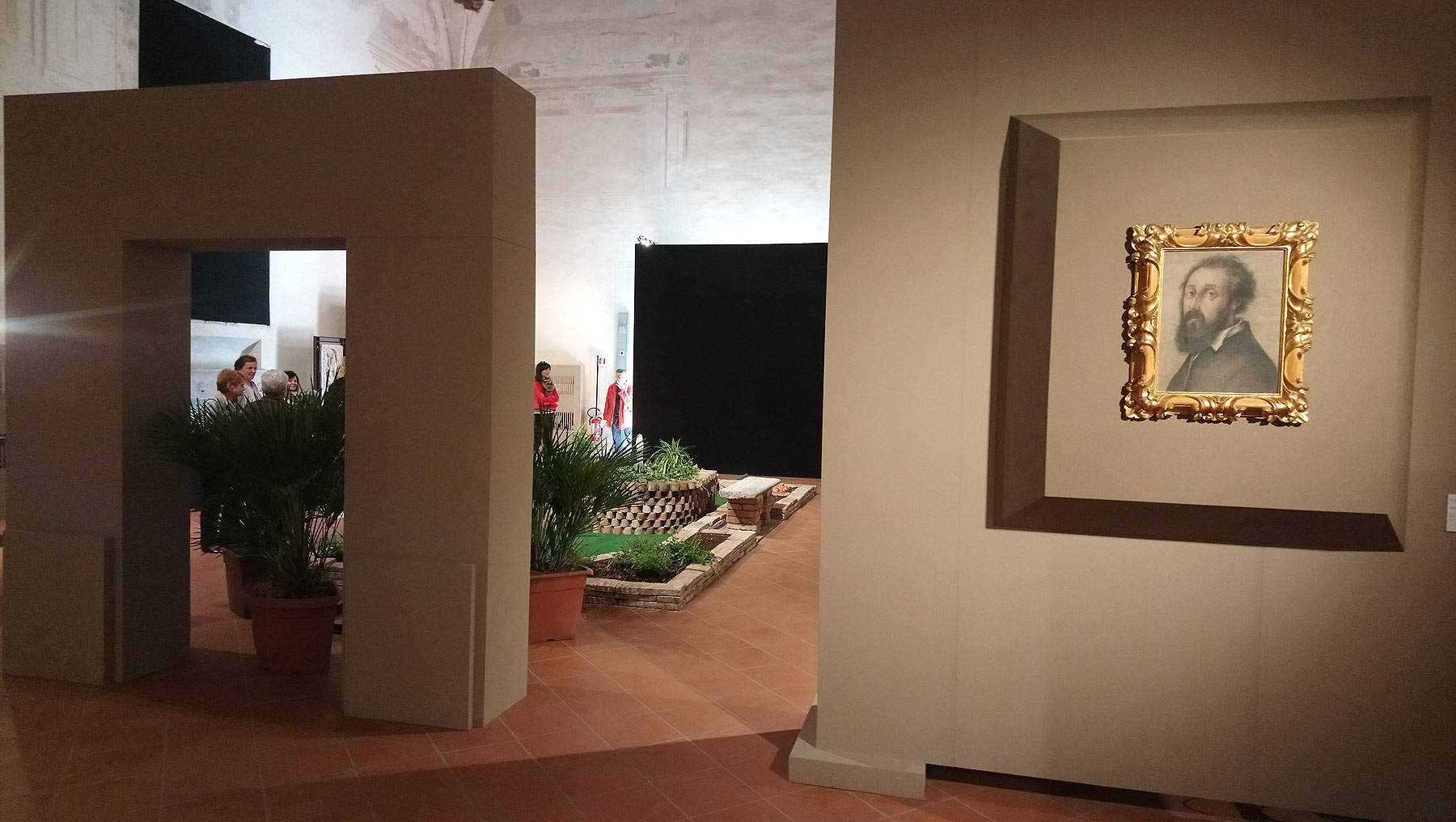 |
| Exhibition The Sixteenth Century in Polirone, San Benedetto Po |
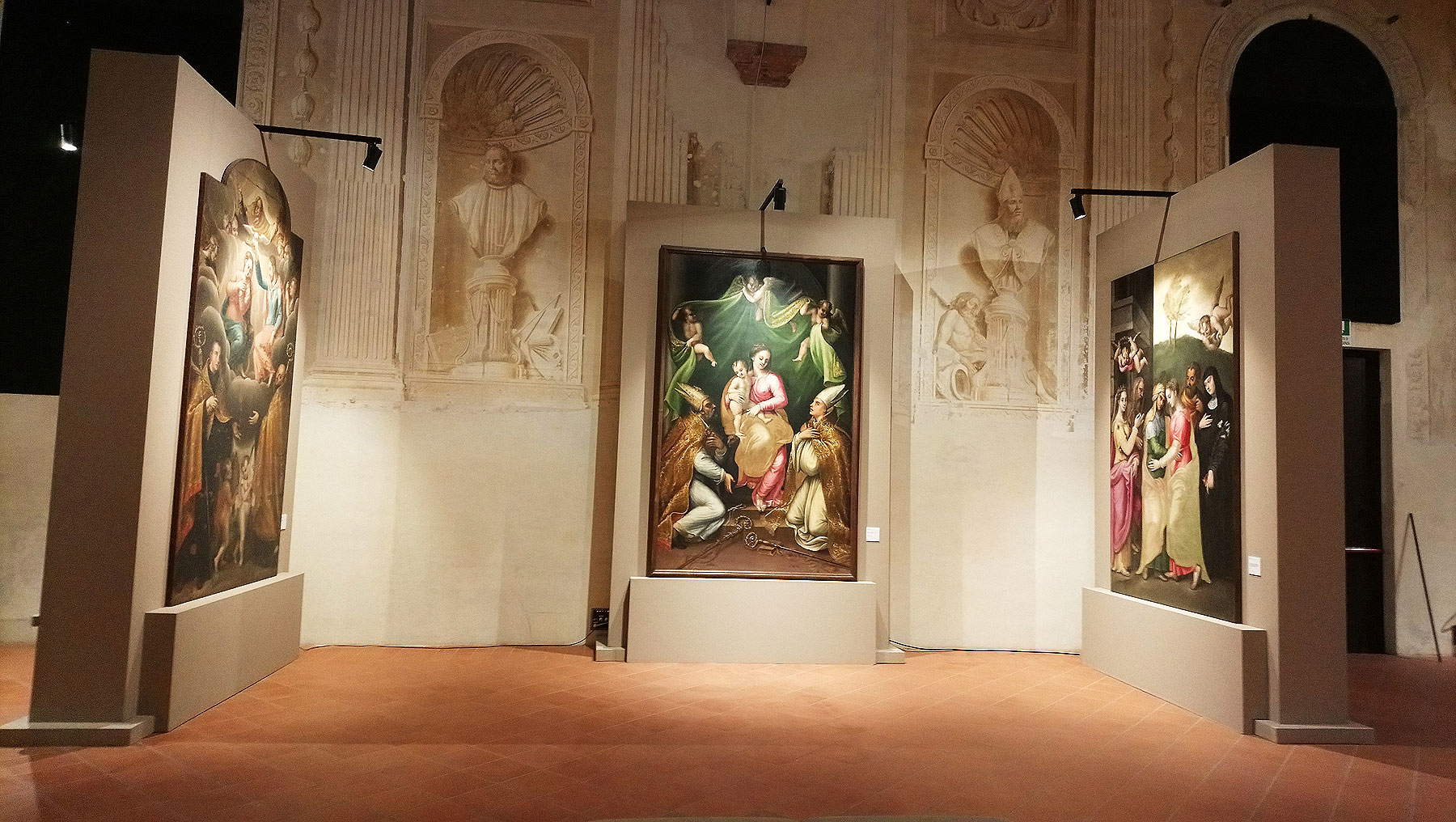 |
| Exhibition The Sixteenth Century in Polirone, San Benedetto Po |
 |
| Exhibition The Sixteenth Century in Polirone, San Benedetto Po |
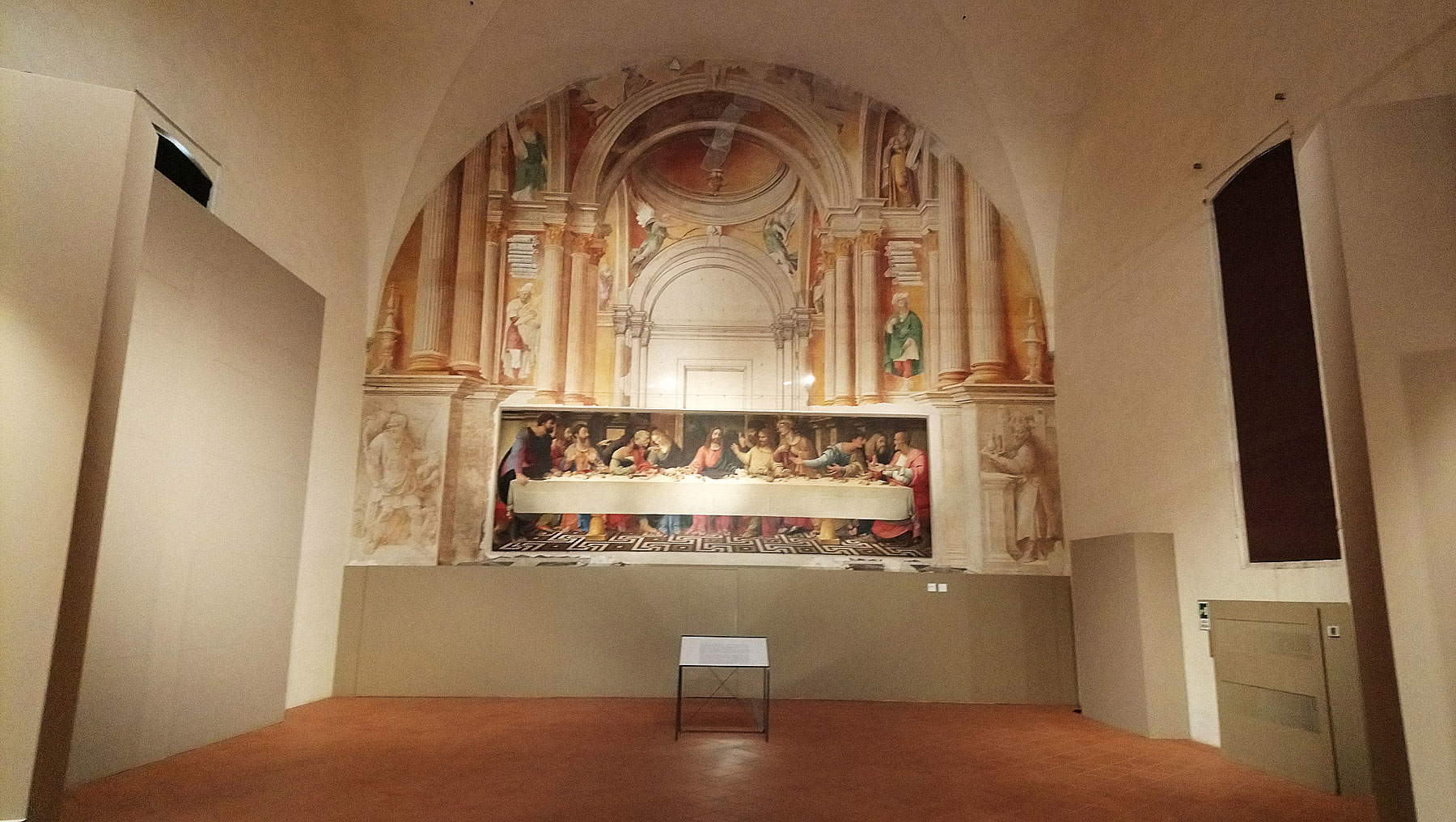 |
| Exhibition The Sixteenth Century in Polirone, San Benedetto Po |
The exhibition’s subtitle, From Correggio to Giulio Romano, makes explicit the idea of the completed exhibition itinerary, manifesting the extremes (in the literal sense of the term) of the arrangement itself: on the back wall stands out the fresco attributed to Antonio Allegri, known as Correggio (Correggio, c. 1489 -1534), although there are those who say it was also done by Bonsignori: the fresco frames the imposing Last Supper. Also by Correggio is the splendid organ casement that has returned to these places after a long time, while the first work that kicks off the exhibition is a Portrait of Giulio Romano attributed to Federico Zuccari (Sant’Angelo in Vado, c. 1540-Ancona, 1609).
The latter, done in watercolor, refers to the portrait preserved at Palazzo Te that Titian (Pieve di Cadore, 1488/1490 - Venice, 1576) executed between 1536 and 1538, and where Giulio Romano is depicted as a court architect while showing the viewer the design of a building still unidentified today. Unlike the Titian portrait, the work in the exhibition depicts only the close-up of the artist, up to his shoulders, in a pale, dim light far removed from his model.
Alongside the portrait, a contract bears witness to the agreement made on “dì 3 de zenaro 1541” through which “messer Iulio Romano promises, et obliga al monastero de Sancto Benedecto de Mantua far li sei quadri”: six altarpieces, five for the side chapels and one for the high altar, to be made within two years. The altarpieces were supposed to be painted by his own hand, putting all his skill and studies into practice, but the only remaining altarpieces of these were executed, at least partially, in his workshop, specifically by Fermo Ghisoni (Caravaggio, 1505 - Mantua, 1575). Thus L’incontro della Vergine con santa Elisabetta alla presenza dei santi Giustina, Gioacchino, Giuseppe e Scolastica, L’Incoronazione della Vergine con i santi Placido e Mauro, and Madonna col Bambino tra i santi Ambrogio e Bernardo are exhibited here. Ghisoni also made, in collaboration with Girolamo Mazzola Bedoli (Parma, c. 1500 - 1569), the high altarpiece depicting theAdoration of the Magi, now in the Louvre following the Napoleonic spoliations; to this group would also have to be added the St. Peter modicae fidei, present in the exhibition, also attributed to the workshop of Giulio Pippi, known as Giulio Romano. According to these pictorial accounts therefore the agreement was not formally fulfilled and visitors can take note of this in front of the only works that resulted from the contract. However, these are works whose attribution has been debated because of the rather precarious condition they were in before the recent restoration, especially with regard to theEncounter; still awaiting restoration, as can be seen in the lower part of the painting and in the robes of Mary and Christ, is instead theCoronation, now housed in All Saints’ Church in Mantua, but evident in Mary’s posture and face is the reference to the Madonna depicted between Saints Ambrose and Bernard and the influence, as the curator states, of Correggio’sCoronation of the Virgin for the central group. The Saint Peter Saved from the Waters is the subject of a chronological debate: it has long been considered a late 18th-century copy of an original by Giulio Romano, but diagnostic investigations have uncovered pentimenti (the presence of which would cast doubt on whether it is a copy) and a 16th-century tablecloth as support. The cloth would thus be dated to about 1542.
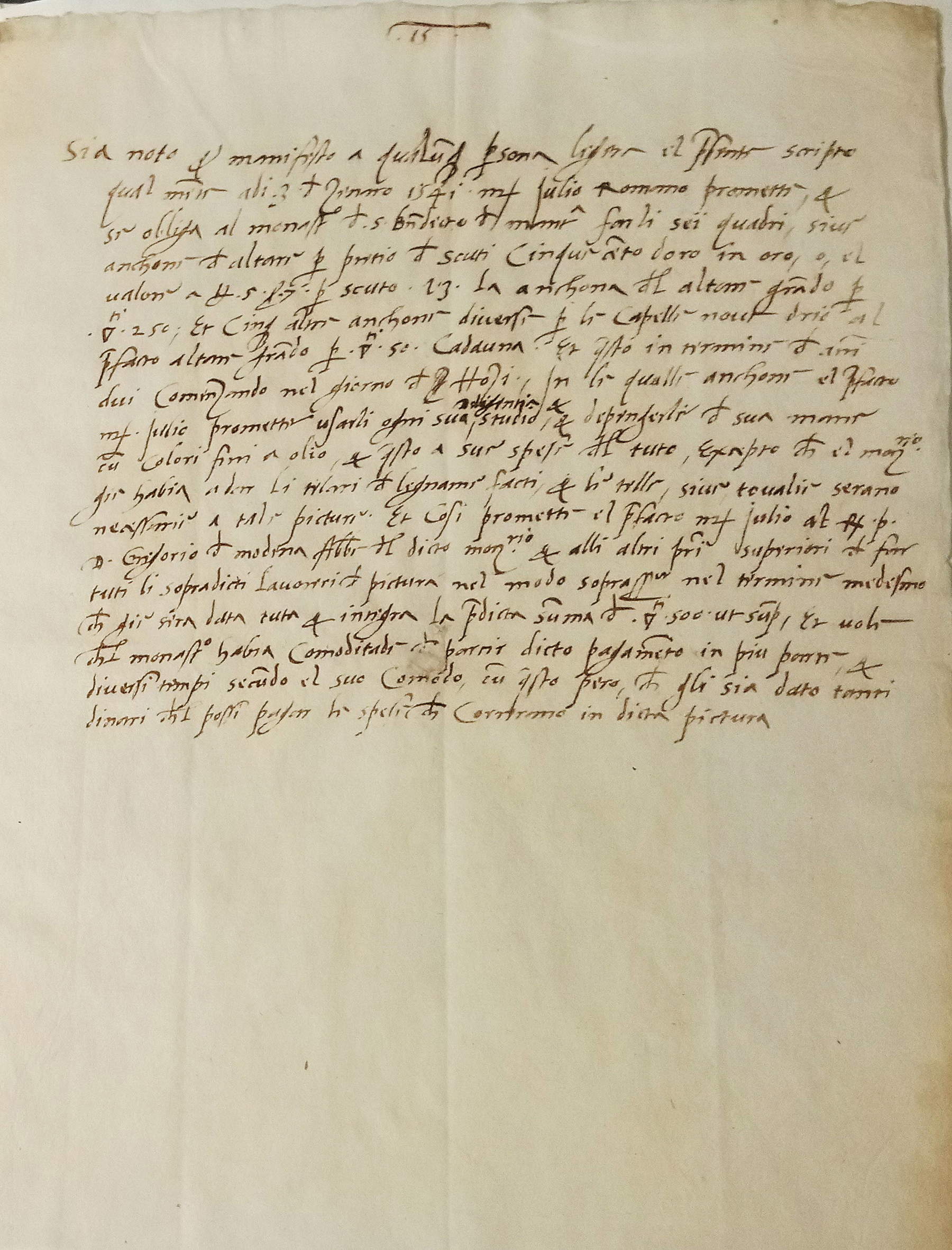 |
| Agreement between the monastery of San Benedetto in Polirone and Giulio Romano for the execution of six altarpieces (January 3, 1541; pen and ink on paper, 210 x 285 mm; Mantua, State Archives) |
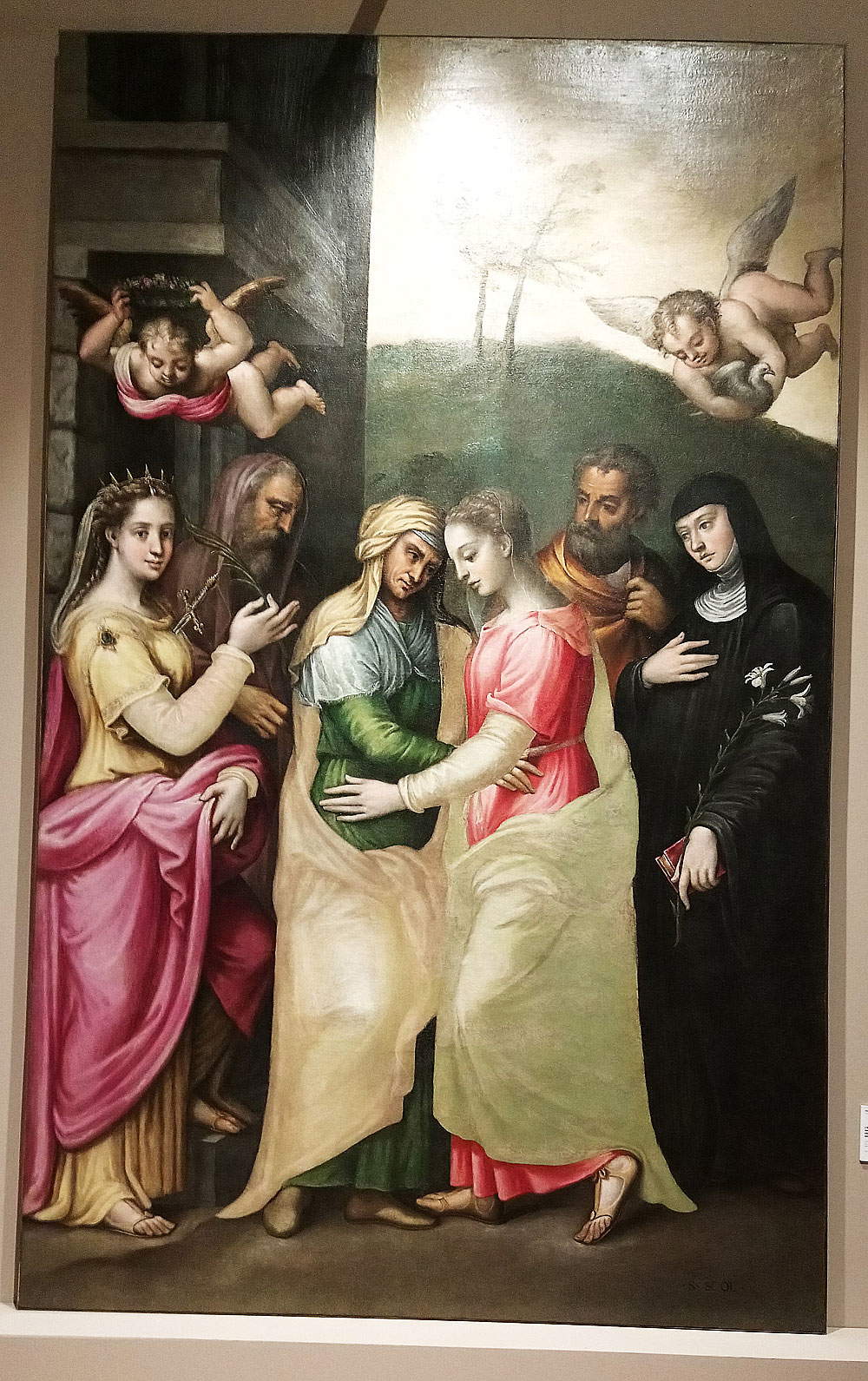 |
| Fermo Ghisoni, The Meeting of the Virgin with Saint Elizabeth in the Presence of Saints Justina, Joachim, Joseph and Scholastica (c. 1542; oil on canvas, 288 x 176 cm; San Benedetto Po, Basilica) |
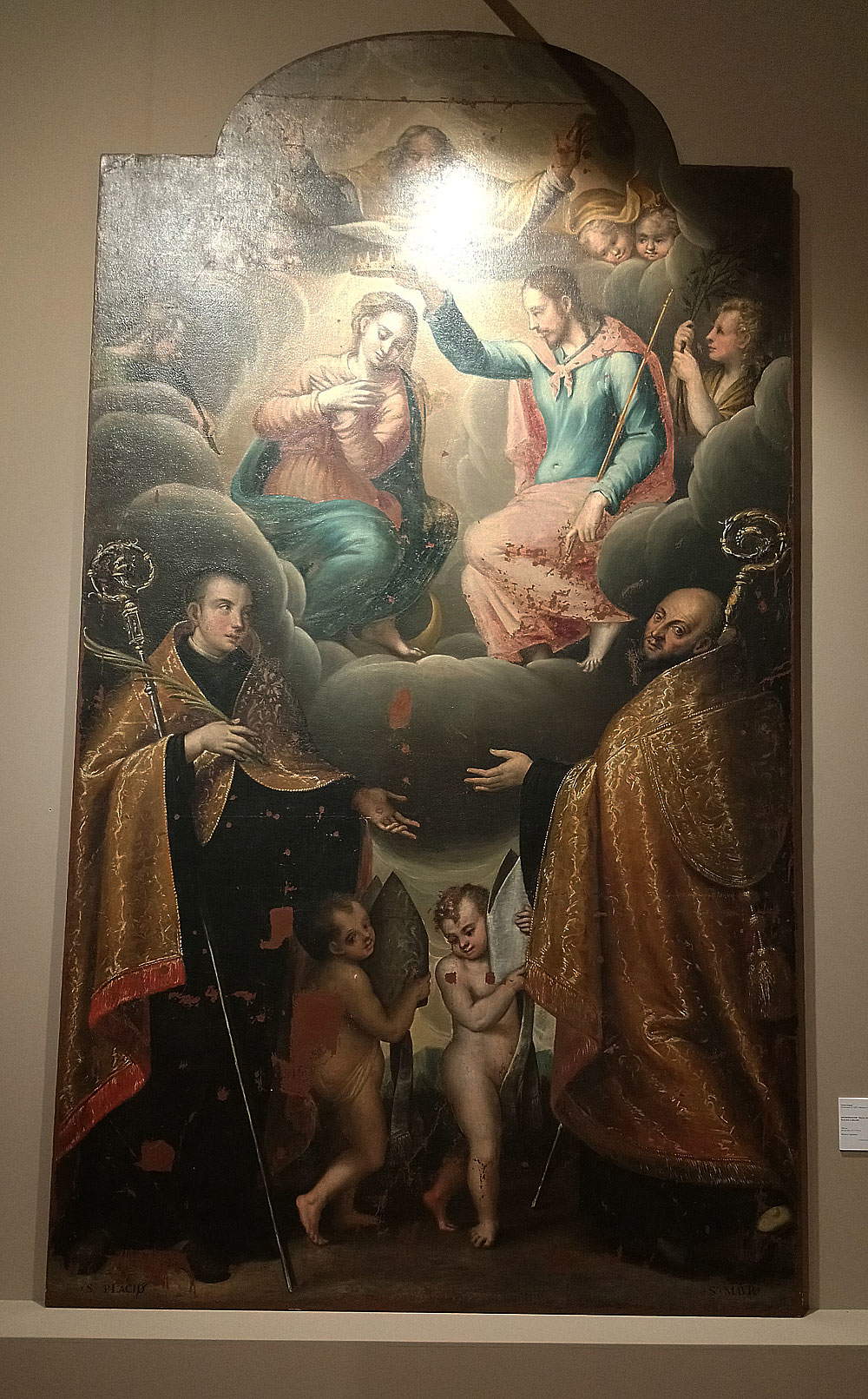 |
| Fermo Ghisoni, Coronation of the Virgin with Saints Placido and Mauro (c. 1542; oil on ribbed canvas, 315 x 175 cm; Mantua, All Saints Church) |
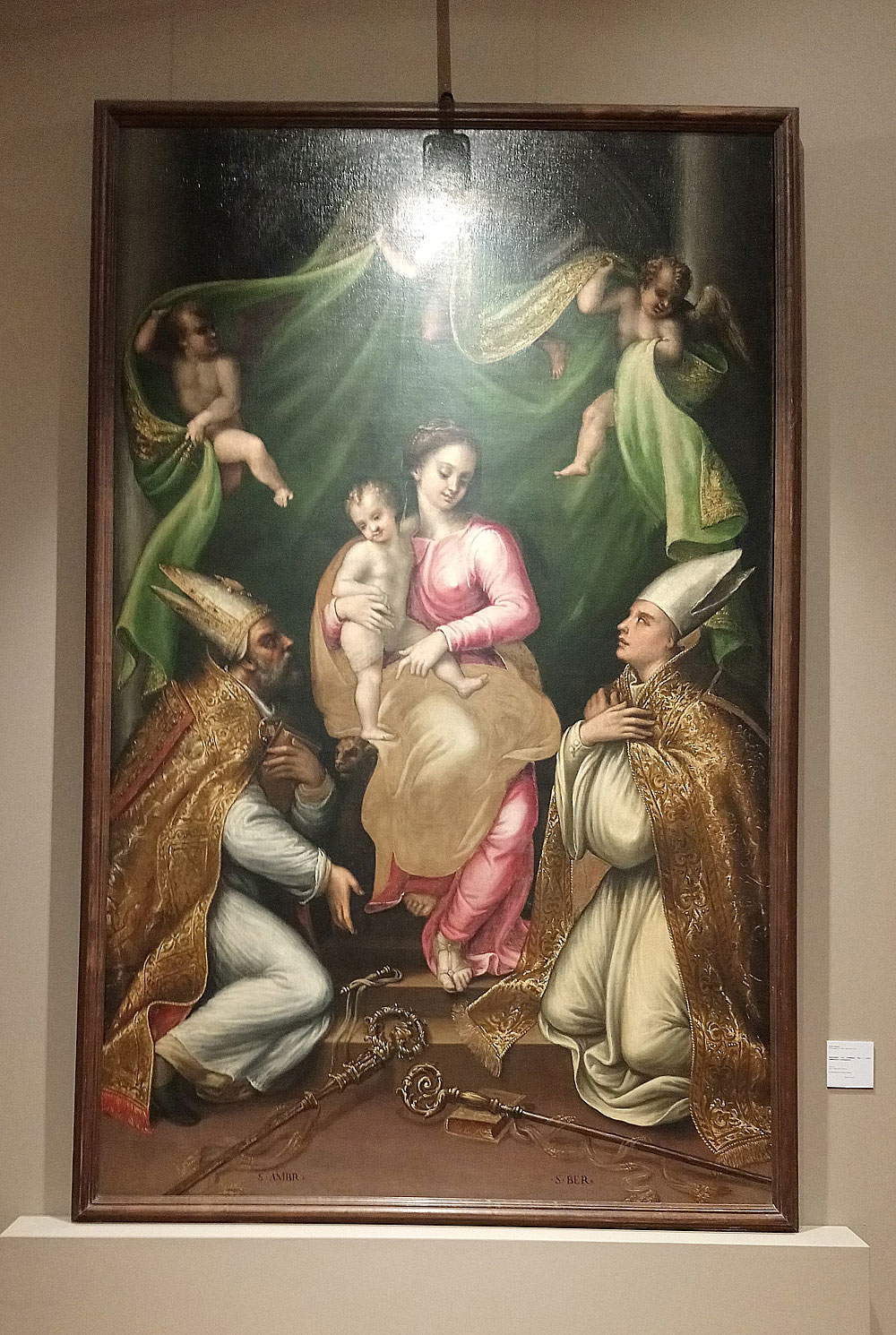 |
| Fermo Ghisoni, Madonna and Child between Saints Ambrose and Bernard (c. 1542; oil on canvas, 295 x 190 cm; San Benedetto Po, Basilica) |
Another contract on display in the exhibition thanks to the loan of theState Archives of Mantua is the one signed on September 8, 1514 between Correggio and Benedetto da Cremona, reverend of the basilica of San Benedetto Po: according to what is written in the document, a testimony of great importance for Allegri’s activity in the Polironian complex, Correggio undertook to paint the wings and the podium, or balcony, of theorgan of the abbey church by the following Easter, April 8, 1515. Again, only part of these stipulated works have come down to us, since the balcony and a leaf depicting Moses with the ark have been lost, while on the occasion of the exhibition the other organ leaf, the one depicting David bringing the Holy Ark back to Jerusalem, belonging to a private collection in Turin, has returned to its place of origin. An additional pride for the citizenry. Inspired by Mantegna, the canvas was attributed to Correggio by Giovanni Romano between 1997 and 1998.
In the foreground the procession follows David clutching the Holy Ark: the iconographic reference to the Triumph of Caesar by Andrea Mantegna (Isola di Carturo, 1431 - Mantua, 1506) in the Royal Collection is remarkable. David Ekserdjian in his catalog essay delves into Antonio Allegri’s Polironian activity, starting precisely with the organ door: there is evidence of the fundamental role that Mantua played for the beginnings of his career (think of the frescoes in Mantegna’s funeral chapel inside the church of Sant’Andrea). In the city he produced two canvases for the Studiolo of Isabella d’Este, and the commissioners of some famous masterpieces are also linked to Mantua: theEducation of Love in the National Gallery and Venus, Cupid and a Satyr in the Louvre for Count Nicola Maffei, who was very close to Federico II Gonzaga, and it was Federico himself who commissioned the Loves of Jupiter as a tribute to Charles V of Spain.
Lanzi ’s Storia Pittorica mentions the “young Mantegni ”and in particular one Carlo del Mantegna: “It is believed that Carlo had a part in the works of the palace and the chapel referred to above,” that is, Mantegna’s funeral chapel, “and in others that are ascribed to Mantegna; among which are two instories of the Ark in the monastery of San Benedetto in Mantua, where the manner of Andrea is seen again somewhat enlarged, although of less beautiful forms.” Actually that Carlo by Mantegna, whose existence is unknown, was in all probability Correggio, given the coincidences. In any case, the artist depicted as already stated the procession with two oxen pulling the chariot on which the ark of the covenant is placed; on the left, David with a crown on his head and in his hands a psaltery; on the right, a man dressed as a Jewish priest looks behind him and holds a scroll and a flowered staff; behind both, people play wind instruments.
The organ casement is placed in direct comparison with the large fresco on the back wall of the Refettorio Grande, almost as if to participate in the debated attribution issue that still oscillates between Correggio and Girolamo Bonsignori, the same artist who painted theLast Supper received in the fresco. Giuseppe Adani, in the work’s file, recalls that Gregorio Cortese, vice-abbot, accompanied Correggio to Rome in 1513 for study and updating, after the Polironian monastery had already acquired Bonsignori’s Last Supper , and together they designed the theme of the fresco: an imposing temple in the manner of Solomon’s Temple and with Bramantean inspiration, where the artist erects columns, capitals, vaults, domes; within this architecture he introduces prophets, Old Testament figures, pagan characters, and sibyls. On either side of the Upper Room, two statue-like monochromes depict Abraham agreeing to sacrifice his son Isaac and Melchizedek offering bread and wine to the Lord.
Without any doubt, however, Girolamo Bonsignori, a Dominican friar, was inspired by the Last Supp er by Leonardo da Vinci (Anchiano, 1452 - Amboise, 1519) in making his Last Supper placed within the fresco discussed above. Although at first glance the two works are very similar, if we analyze the details well we realize the many differences in the figures, architecture, floor and table. In fact, the figures depicted appear much closer together than in the Da Vinci Last Supper; behind them we notice a more majestic architecture, just as the meandering floor is more precious. On the table (note also the legs of the same much more massive and decorated) are counted many more glasses and cruets and pieces of bread than in the Leonardo work. This is a perfect theme for the setting for which the painting was intended, since we find ourselves in a refectory, where the monks devoted themselves to communal meals. And it was precisely the monk Gregorio Cortese who wanted this painting as part of his renovation of the Polironian complex, since the canvas dates from around 1514. Until the end of the eighteenth century it is attested to have been in the refectory and until the second French domination at the Polirone; later it appears in a list of works destined for the Count d’Espagnac ’s palace in Sassuolo and then it arrived in France where it remained for several decades. In Italy it is documented in 1927 at theAbbey of Vangadizza in Badia Polesine and is still kept here today, although it also suffered a fire and subsequent restoration.
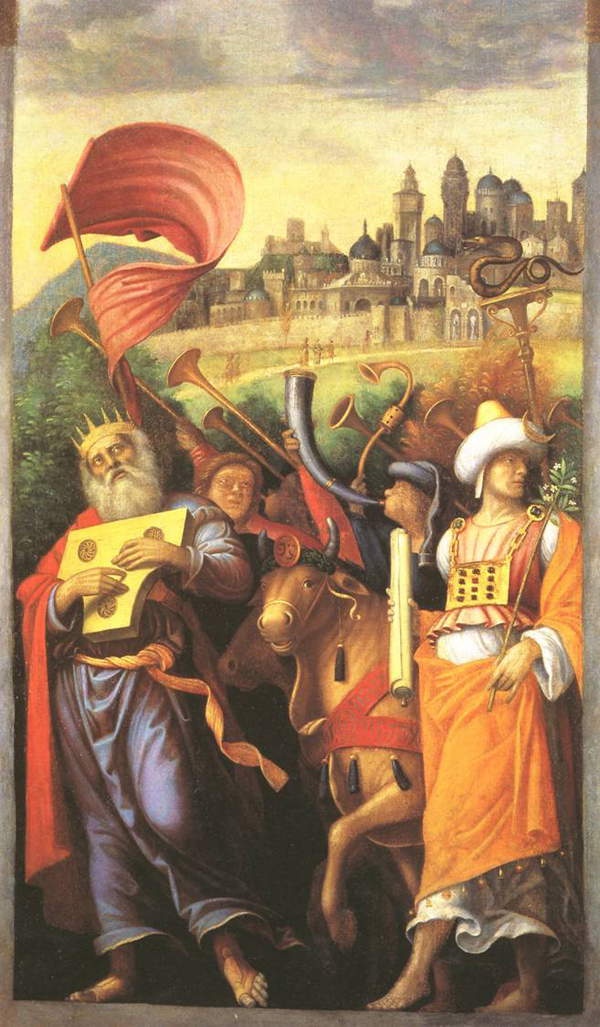 |
| Correggio, David Returns the Holy Ark to Jerusalem (1514-1515; oil on canvas, 260 x 153.5 cm; Private collection) |
 |
| Girolamo Bonsignori, Last Supper (c. 1514; oil on canvas, 234 x 722 cm; Badia Polesine, Museo Civico) |
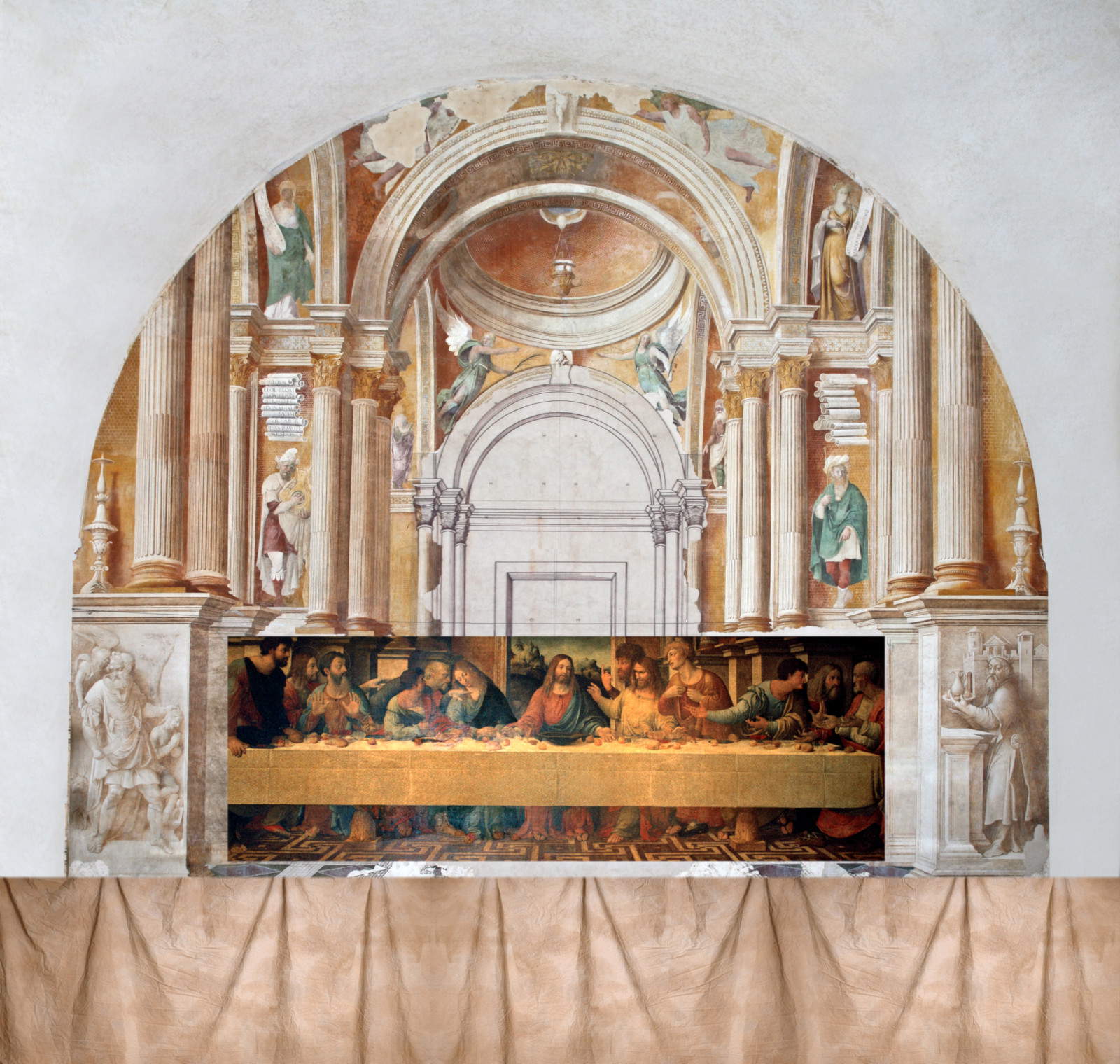 |
| Correggio or Girolamo Bonsignori (attributed to), Architectural setting of Girolamo Bonsignori’s Last Supper (c. 1514; fresco and dry-painting interventions, 1170 x 1135 cm; San Benedetto Po, Refettorio Grande) |
If, in the room, to the left of the fresco and theLast Supper , it has been said that Correggio’s organ door is on display, to the right are some drawings by Giulio Romano, in a further reference to the extremes of the exhibition’s subtitle. Among these drawings, one depicts David and Bathsheba at the bath, that is, one of the octagons of the Loggia of David in Palazzo Te: Bathsheba, naked, is covered with a cloth by one of her servants after bathing in the fountain of the garden where she stands; at the window, on the other hand, David with the crown on his head is informed by another man about the maiden’s identity. The work testifies to the preponderant role Giulio Romano gives to drawing and his enchanting skill in technique.
Completing the exhibition is a selection of works, including paintings and sculptures, created in the sixteenth century in the post-Julian period. From the Venetian school is the Madonna and Child by Paolo Farinati (Verona, 1524 - 1606), a painting in a private collection that depicts the sweetness with which the Child looks at his mother and caresses her face and the Madonna holding her child on a pillow. The same theme is portrayed in sculpture by Antonio Begarelli (Modena, 1499 - 1565), a Modenese artist who was commissioned in the 1440s to create terracotta statues for the Polyronian complex. In this case the Madonna is standing over a monstrous reptile-like being and holding the Child, who, however, seems to want to wriggle away unlike in Farinati’s painting; probably the demonic being refers to the defeat of evil through Christ’s sacrifice. Begarelli later made some 20 statues for the Polirone to be placed in the niches of the nave and portico depicting saints, and in fact the review also includes a visit to the Basilica to invite the public to admire the splendid statues created by the artist that look like marble, so meticulously executed were they and technical skill; in some cases, as in St. Justine or St. Lawrence, the sculptor added gold leaf finishes and touches of color to give greater realism to the statues, and even iron and wooden elements.
 |
| Giulio Romano, David and Bathsheba at the Bath (1531; pen and brown ink, brush and brown watercolor with traces of black chalk on brownish prepared paper, 365 x 281 mm; Private collection) |
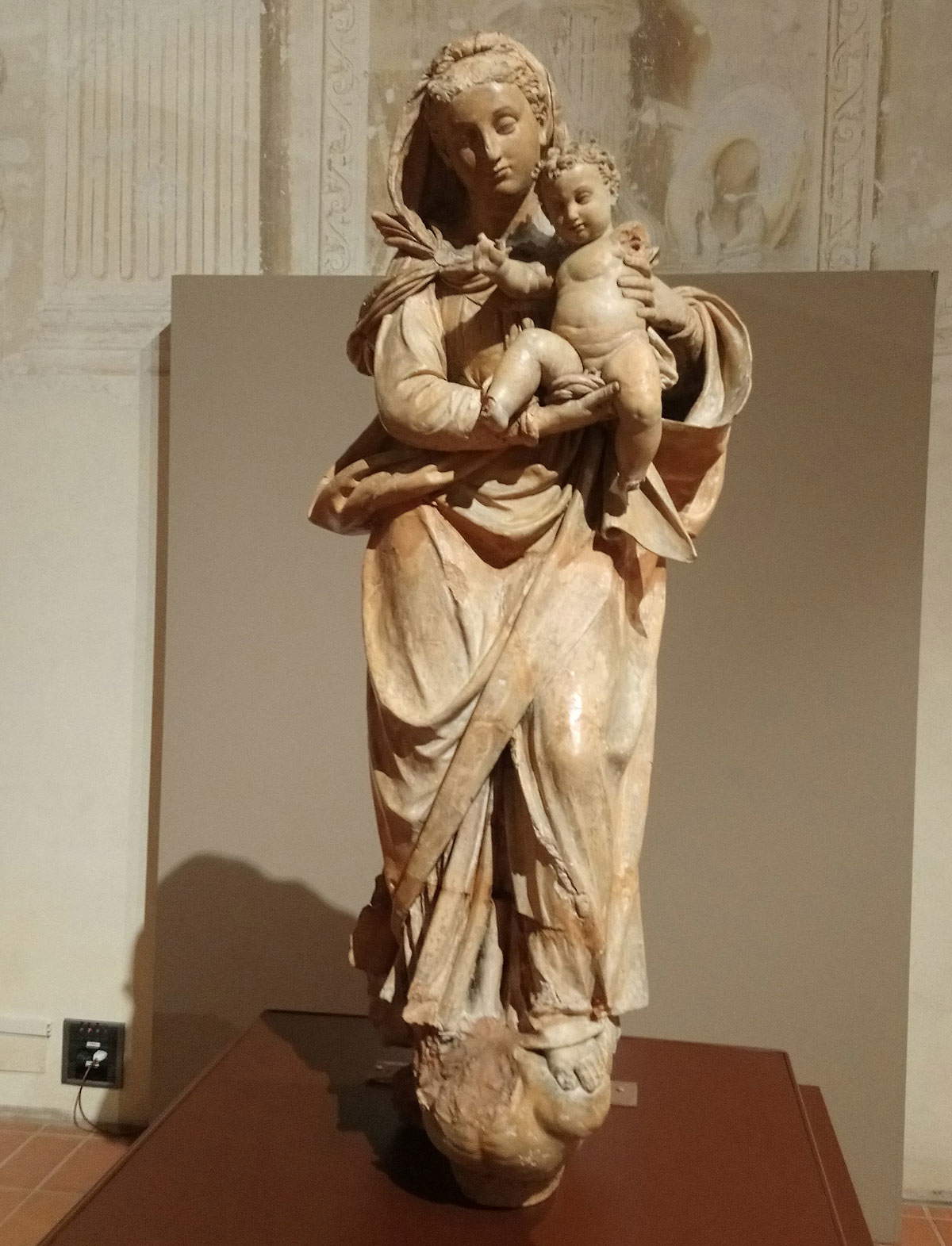 |
| Antonio Begarelli, Madonna and Child (c. 1541; terracotta, 142 x 61 x 40 cm; San Benedetto Po, Museo Civico Polironiano) |
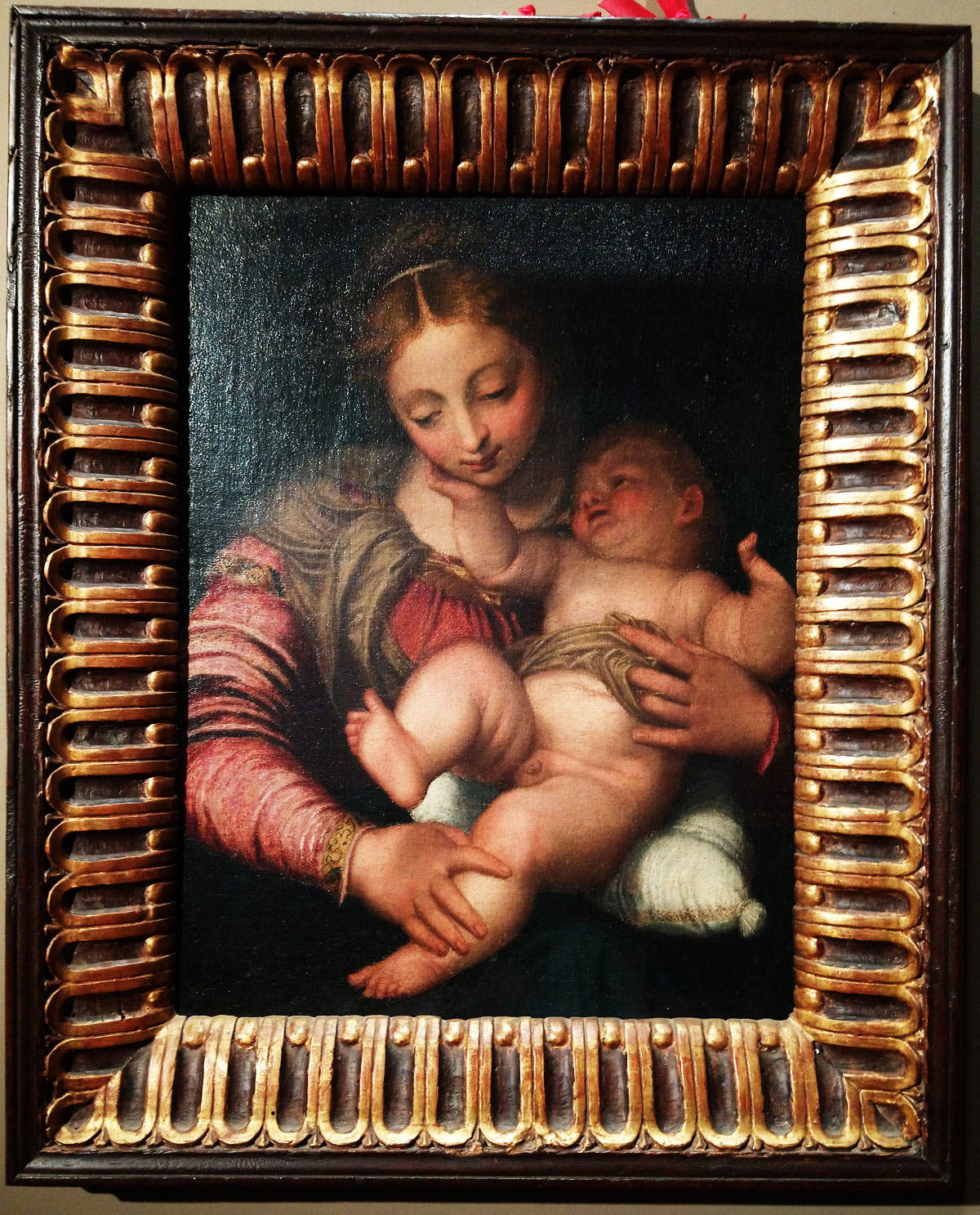 |
| Paolo Farinati, Madonna and Child (eighth decade of the 16th century; oil on canvas, 44.5 x 33 cm; Private collection) |
It is incredible to think how a basilica in a small town in the Po Valley holds such treasures as the ones mentioned above: undoubtedly the Polirone complex was an important monastic center at that time, thanks to the great renovation project commissioned by Gregorio Cortese, which made possible in particular the presence of a marvelous series of sculptures created by Begarelli and ceiling decorations by Giulio Romano. As in the sacristy, where a liturgical section has been set up: in the cabinets vestments divided by day and festivity are kept, and one is displayed in rotation among those of rare workmanship dating from the 15th and 16th centuries. Also preserved inside the Basilica is the tomb of Matilda of Canossa: it was her grandfather who founded the monastery in 1007 on an island between the rivers Po and Lirone, around a church dedicated to Santa Maria; the tomb is still in its original location, thanks in part to the contribution of Giulio Romano who, in agreement with Gregorio Cortese, had the tomb brought back to that spot, after it had been moved to the entrance of the main church and then to the altar of Santa Giustina. Although for centuries the tomb has been empty: Matilda’s body is buried in St. Peter’s in Rome, surmounted by a statue by Gian Lorenzo Bernini.
Another aspect to remember was the flourishing activity of the scriptorium attested in the exhibition by codices with Girolamo dai Libri ’s miniatures from theDiocesan Historical Archives.
It is an exhibition that touches on all aspects that contributed to the importance and greatness of the Polirone in the sixteenth century. Understandable to all, it is a well-curated exhibition from the point of view of content, as is also demonstrated by the exhibition catalog itself, in which several essays are offered that delve into topics such as Correggio’s and Bonsignori’s activities in Polirone, Begarelli’s sculpture, the Juliesque renovation to the monastic complex, and the sixteenth-century artistic context in these places. Each work is also accompanied by a fact sheet, an essential element for a good understanding.
An exhibition that achieved the return of two important works to their place of origin and gave due glory to Giulio Romano as the artist of the eternal San Benedetto.
Warning: the translation into English of the original Italian article was created using automatic tools. We undertake to review all articles, but we do not guarantee the total absence of inaccuracies in the translation due to the program. You can find the original by clicking on the ITA button. If you find any mistake,please contact us.